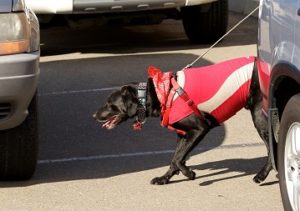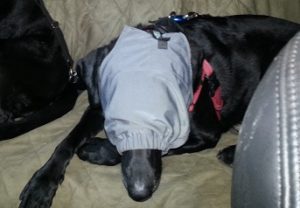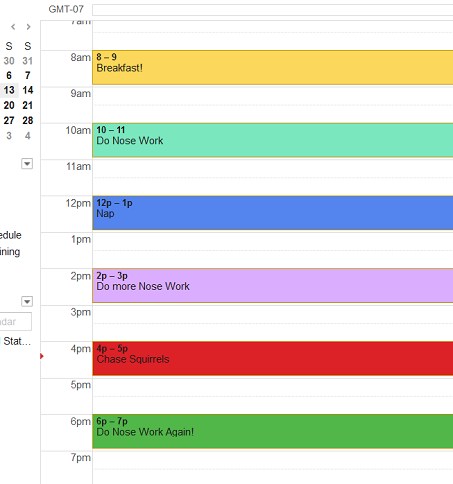Is your dog ready for Trial day challenges? Routines are comforting, especially to dogs. Dogs can’t comprehend leather-bound day planners or smart phone calendar apps. Dogs learn what to expect from prior experiences. Studies have shown that being able to predict what happens next reduces stress. Routines set future expectations. Consistent routines are especially helpful for anxious dogs (and people), who already have enough to worry about!
Perhaps your dog is happy-go-lucky, easily goes with the flow, and seldom gets rattled. Count your blessings! Skip this blog post, and go do something fun and exciting with your dog!
If not, read on.
Is your dog familiar with Trial day challenges?
If you’d like to compete, it’s a good idea to get your dog used to things that will happen on Trial day. If your dog is anxious or insecure, make sure you go slowly, with many repetitions. Your goal is to make these new routines seem, well, routine. Watch for signs of stress, to know if you’ve overdone it, or can stretch a bit farther next time.
Getting up early
If you are very lucky, you’ll get into a Trial that is pretty close to home. More likely, you’ll have to drive an hour, maybe two, maybe more. You may enter a Trial so far away that you’ll want to stay overnight — a whole separate topic! For now, if your dog stresses when you change your morning routine, practice what you’ll be doing on Trial day a few times, so that he won’t be alarmed by the early morning activity.
Taking a long car ride
How close are Trials to where you live? How far are you willing to drive, to complete? Is it farther than your dog is used to traveling in the car? If so, try to work in some longer drives before the Trial day. If you want to build up to a 2-hour drive, and your dog’s longest drives are 20 minutes, pick someplace 30 minutes away and have fun there with your dog a few times. When your dog has accepted that, increase to 45 minutes, then an hour, etc. Before you increase the driving time, always make sure your dog can handle the current maximum easily.
Patiently waiting one’s turn
You will be at the Trial site for several hours, from early morning through late afternoon. Has your dog practiced waiting in the car for long stretches? Will she think it’s odd? Will it stress her out? Will she be too energetic to sit still?
There’s an easy way to work up long waits in the car, if circumstances allow: Go to Nose Work class early and stay late. If your dog doesn’t have separation anxiety, you can benefit from watching the other dog/handler teams searching. In any case, your dog will be familiar with the routine: Lengthy waits before and after searches.
(Side note about dogs in hot cars: that will be covered in another post. Your best bet: Ask your instructor for assistance and advice.)
Going to new locations
Nose Work Trials are held, purposefully, in locations dogs don’t generally frequent. It is very unlikely that your dog will have searched there before.
Make sure that you search in many locations, and that your dog doesn’t just associate one or two locations with Nose Work. It’s best if you play in enough locations that your dog will think: Nose Work can happen ANYWHERE, and brand new places can be AWESOME! Until your dog gets very used to searching in new places, set easier hides, and always save the hardest hides for familiar locations.
Even if your dog is the best Nose Work dog ever, it is not fair to bring her to a Trial if she is scared of new places. Take the time to gently desensitize her to new places. If new places make your dog anxious, visit a new place with her, and feed her very good treats for being brave. Try to read whether she feels safe. Ideally, leave while she’s still feeling calm. Repeat: very gradually increase the duration of the visits. Once she relaxes, do some easy hides.
Strange dogs
While there are rules in place, at an NACSW Trial, to keep dogs several feet away from each other, your dog will still hear and maybe see other dogs from the car, and certainly while using the potty area, and going to/from the search areas. If your dog is unruly when seeing other dogs while on leash, you will have to consider whether to do behavior modification and counter conditioning before entering a Trial.
If your dog could use extra space from other dogs, tie a red bandanna around his neck, or attach it to his harness. Some people wear the red bandannas their own belts, leading to jokes about whether it’s the dog or the handler who is reactive. Keep in mind, even with a red bandanna, your dog will have to get around with other dogs in the vicinity.
Strange people
No one should try to interact with your dog in any way, without asking first. If your dog is very fearful of people, however, she may not be ready for a Trial. Volunteers will approach you to guide you to your staging areas. In the search area, your dog is likely to see men and women wearing hats, carrying clipboards, timing with stopwatches, and taking videos and pictures. Find out more about whether your dog’s fear of people would make a Trial too hard to handle.
Using tools
Music
If you would like your dog to be calmer in the car, we suggest Through a Dog’s Ear, now knows as iCalmPet. The music is tailored to provide maximum canine relaxation. In addition, the music may help drown out noises your dog hears outside of the car. Lastly, the music is pretty effective at calming humans as well!
Clothing
For general anxiety, the ThunderShirt can be helpful, particularly for dogs with short or thin fur; dogs with thick coats tend to get less benefit from it. Your dog may wear a ThunderShirt at Trials, including during the search.

If your dog goes crazy over things he sees outside of the car, try a ThunderCap, formerly knows as a Calming Cap. At Trials, your dog may wear a ThunderCap inside the car, but not outside of the car. My dog Tigger wears a ThunderCap every time he rides or rests in the car. It reminds him to lie low in the car, instead of staring out the window looking for things to bark at. Along with training, the ThunderCap has helped Tigger learn to nap in the car, so he arrives at his destination calm and ready for work, instead of riled up, hyper, and exhausted.

Touch
TTouch, or Tellington Touch, is a gentle massage system that can help keep your dog calm and balanced. At our first ORTs and Trials, I sat in the car with Tigger and helped him relax with TTouch. One nice thing about TTouch is that the practitioners teach you to do it yourself. To find a practitioner, click here.
High tech tools
The Pet Tutor and other treat dispensing machines can also be very helpful to keep your dog calm in the car, while driving or while waiting. Just be careful not to over-feed before Nose Work. He likely won’t search very well if he’s overly full, just as we don’t perform at our best after a large Thanksgiving meal.
If your dog is always anxious and doesn’t even know how to relax, or is perhaps extremely fearful, a visit to a veterinary behaviorist may provide the relief your dog needs.
Tools to avoid
Calming pheromones and essential oils have become quite popular recently. The NACSW bans them at Nose Work Trials, and rightly so. It is unfair to the next dogs, to contaminate search areas with the residue of these odors. Be respectful of others. If you use the pheromones, leave them at home for Nose Work Trials. And please, never bring any therapeutic essential oils to any Nose Work activities, official or otherwise.
What do you do?
How do you help your dog feel comfortable in new or stressful situations? Please share, I sincerely would like to know.
Trial day challenges
Trial day is stressful. You can relax more, if your canine partner is stress-free. Take time to make trial day challenges seem like routine experiences. You’ll be glad you did.
Copyright Linda Fletcher 2016

